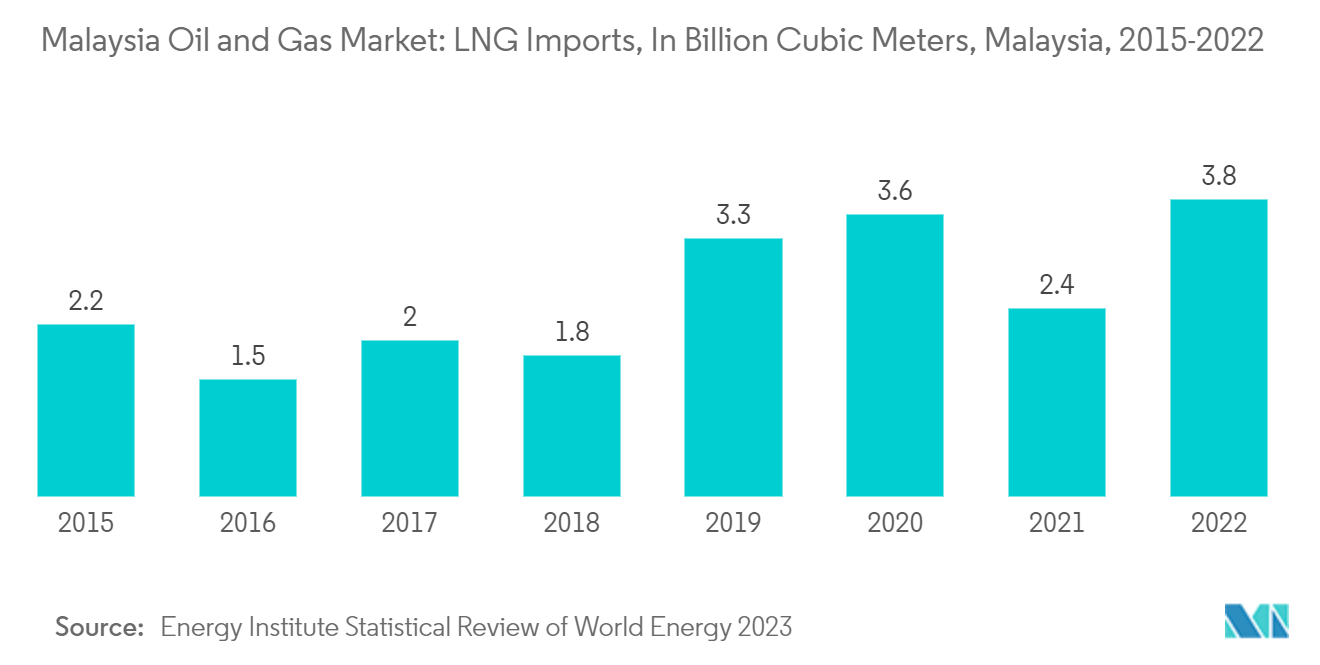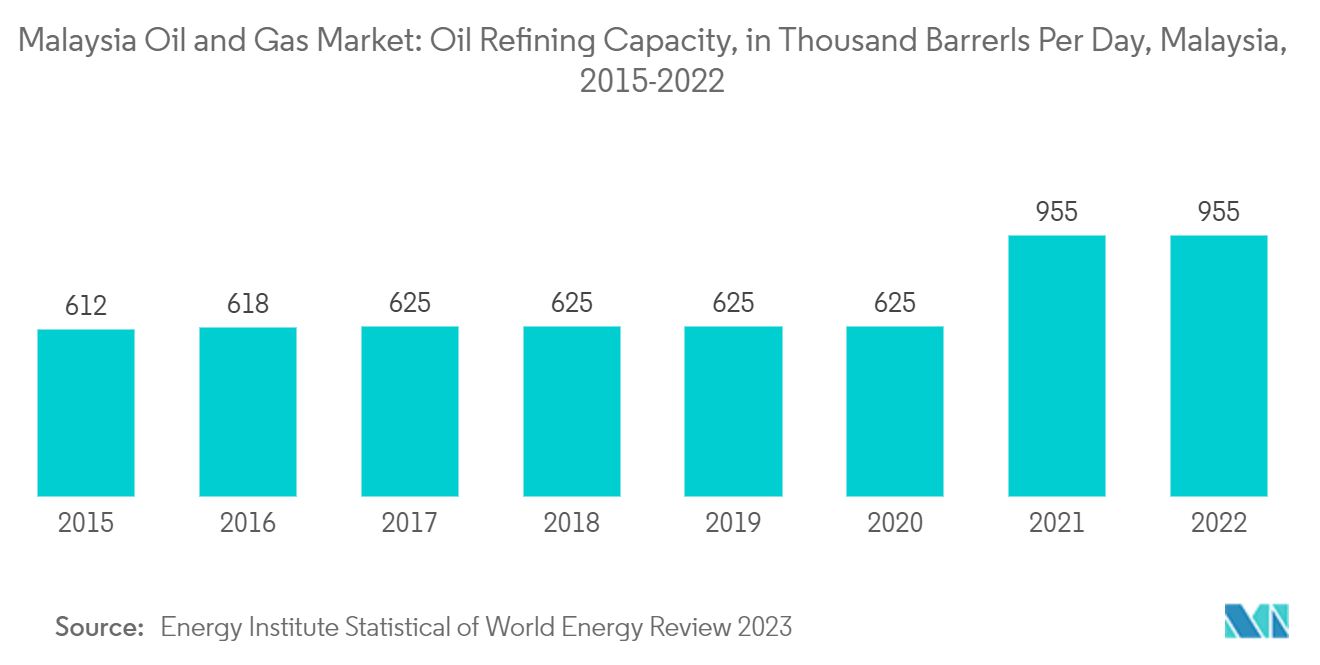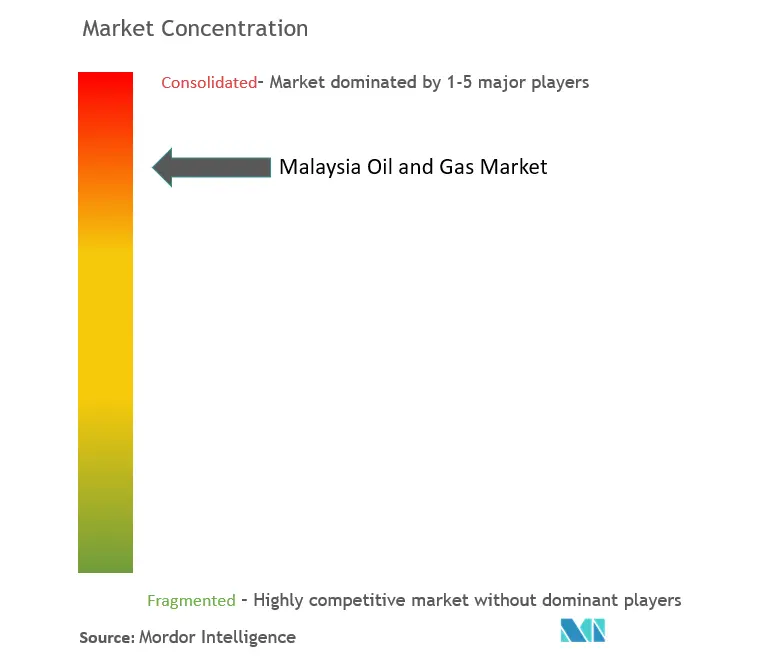Malaysia Oil and Gas Market Size

| Study Period | 2019 - 2029 |
| Base Year For Estimation | 2023 |
| Forecast Data Period | 2024 - 2029 |
| Historical Data Period | 2019 - 2022 |
| CAGR (2024 - 2029) | 1.40 % |
| Market Concentration | Medium |
Major Players.webp)
*Disclaimer: Major Players sorted in no particular order |
Malaysia Oil and Gas Market Analysis
The Malaysia Oil And Gas Market size in terms of production volume is expected to grow from 679.38 Thousand barrels per day in 2024 to 728.29 Thousand barrels per day by 2029, at a CAGR of 1.40% during the forecast period (2024-2029).
- Over the medium term, factors such as supportive government policies, growing efforts to boost domestic oil and gas and LNG production, the surge in demand for refined petroleum products, and upcoming oil & gas projects and upgrades are expected to drive the market.
- On the other hand, the high volatility of crude oil prices due to many factors and the increasing adoption of renewable energy may restrain the market.
- Nevertheless, a high number of discoveries in recent years and ongoing exploration activities are expected to provide a significant opportunity for players in the country's oil and gas market.
Malaysia Oil and Gas Market Trends
Midstream Sector is Expected to Have Significant Market Share
- Malaysia has an increasing demand for natural gas in the country and neighboring regions. Most countries want to reduce their carbon emissions to control the air quality in the environment, which has increased natural gas consumption in various end-user segments.
- Satu Malaysia Terminal is an LNG terminal in Sarawak, Malaysia. It constitutes three LNG trains and has a capacity of 8.1 million metric tons per annum (MTPA). It is a part of the Malaysia LNG Complex, also known as the Petronas Bintulu LNG Complex.
- As of 2022, the natural gas imports in the country were around 3.8 billion cubic meters per day. The imports increased in 2022 compared to 2021.
- For instance, in January 2022, the Malaysian State of Sabah and Petronas announced plans for a two million metric tons/year (mmty) liquefied natural gas (LNG) terminal. The new facility planned for the Sipitang Oil and Gas Industrial Park is a part of Petronas's collaboration with the state to expand Sabah's distribution of cleaner energy to industrial and commercial businesses.
- Furthermore, in August 2021, the Indian Oil Corporation (IOC) entered a joint venture with Malaysia's state-run Petronas to include building liquefied natural gas (LNG) terminals, fuel retailing, and gas distribution, driving the segment's growth.

Surging Demand For Refined Petroleum Products to Boost the Growth of the Market
- Malaysia's refining sector is witnessing significant growth due to the increasing demand for refined products from chemical, petrochemical, and transport industries.
- Malaysia is Southeast Asia's second-largest oil and natural gas producer and the fifth-largest exporter of liquefied natural gas (LNG) in the world as of 2021. It is strategically located on essential routes for seaborne energy trade.
- Malaysia has witnessed a steady growth in manufactured, refined petroleum product sales for several years. The increase in refined petroleum products can be mainly attributed to the growing demand for LPG as cooking fuel in homes, particularly as a transport fuel.
- As per the Department of Statistics Malaysia, in 2021, Malaysia produced approximately 2.7 million metric tons of liquefied petroleum gas (LPG). The production of LPG in the country has been increasing since 2013, with 2.53 million metric tons produced.
- Malaysia has invested heavily in refining activities during the past two decades to meet its demand for petroleum products with domestic supplies. As of 2022, Malaysia had about 955 thousand barrels per day (b/d) refining capacity in seven facilities spread across the country.
- As part of Malaysia's goal to construct the oil refining and storage hub to meet the domestic demand for refined petroleum products, Petronas has invested about USD16 billion in the Refining and Petrochemicals Integrated Development Project (RAPID) in Johor. At the same time, an investment of nearly USD11 billion for associated facilities. The project has a nameplate capacity of 279,000 b/d and is expected to be fully commissioned by the end of 2022. The RAPID facility will be the country's first refinery to produce diesel and gasoline that meet the Euro V standard, which lowers carbon dioxide emission levels.
- However, with the growing demand for petroleum products and Malaysia's focus on self-reliance to meet the demand, the downstream infrastructure in the region is expected to increase significantly in the coming years. The country has formulated plans to either expand the current refineries or construct new ones.
- Therefore, owing to the abovementioned factors, the growing demand for petroleum products is expected to drive the Malaysia oil and gas market during the forecast period.

Malaysia Oil and Gas Industry Overview
The Malaysia oil and gas market is moderately consolidated. Some of the key players are (in no particular order) BP Plc, Shell Plc, Petronas Gas Bhd, Altus Oil & Gas Malaysia Sdn. Bhd, and ExxonMobil Corporation, among others.
Malaysia Oil and Gas Market Leaders
-
Royal Dutch Shell
-
Altus Oil & Gas Malaysia Sdn. Bhd.
-
ExxonMobil Corporation
-
BP Plc.
-
Shell Plc.
*Disclaimer: Major Players sorted in no particular order

Malaysia Oil and Gas Market News
- January 2023: A consortium of JGC Corporation and Samsung Heavy Industries (SHI) secured an engineering, procurement, construction, and commissioning (EPCC) contract with Petronas for Malaysia's first nearshore floating LNG facility project. The planned facility is set to become the world's first nearshore floating LNG facility. It has a minimum production capacity of 2 million tonnes of LNG annually and is scheduled for completion in 2027.
- December 2022: Petronas announced the oil and gas discovery at the Nahara well in Block SK 306. Petronas Carigali, a wholly owned subsidiary of Petronas, is the operator of the block, with 100 percent participating interest in its Production Sharing Contract (PSC).
Malaysia Oil and Gas Market Report - Table of Contents
1. INTRODUCTION
- 1.1 Scope of the Study
- 1.2 Market Definition
- 1.3 Study Assumptions
2. EXECUTIVE SUMMARY
3. RESEARCH METHODOLOGY
4. MARKET OVERVIEW
- 4.1 Introduction
- 4.2 Crude oil Consumption Forecast in billion cubic feet per day, till 2028
- 4.3 Recent Trends and Developments
- 4.4 Government Policies and Regulations
-
4.5 Market Dynamics
- 4.5.1 Drivers
- 4.5.1.1 Surging Demand For Refined Petroleum Products
- 4.5.1.2 Significant Untapped Petroleum Reserves in the Sedimentary Basins
- 4.5.2 Restraints
- 4.5.2.1 High Volatility of Crude Oil Prices
- 4.6 Supply Chain Analysis
- 4.7 PESTLE Analysis
5. MARKET SEGMENTATION
- 5.1 Upstream
- 5.2 Midstream
- 5.3 Downstream
6. COMPETITIVE LANDSCAPE
- 6.1 Mergers and Acquisitions, Joint Ventures, Collaborations, and Agreements
- 6.2 Strategies Adopted by Leading Players
-
6.3 Company Profiles
- 6.3.1 BP Plc
- 6.3.2 Shell Plc
- 6.3.3 Petronas Gas Bhd
- 6.3.4 Chevron Corporation
- 6.3.5 ExxonMobil Corporation
- 6.3.6 Malaysiaian General Petroleum Corporation
- 6.3.7 Altus Oil & Gas Malaysia Sdn. Bhd.
- 6.3.8 Petro-Excel Sdn Bhd (PESB)
- 6.3.9 Petro Teguh (M) Sdn. Bhd.
- 6.3.10 Malaysiaian Natural Gas Holding Company
- *List Not Exhaustive
7. MARKET OPPORTUNITIES AND FUTURE TRENDS
- 7.1 A High Number of Discoveries in Recent Years and Ongoing Exploration Activities
Malaysia Oil and Gas Industry Segmentation
The oil and natural gas market is a major industry in the energy market and plays an influential role in the global economy as the world's primary fuel source. The processes and systems involved in producing and distributing oil and gas are highly complex, capital-intensive, and require state-of-the-art technology.
Malaysia's oil and gas market is segmented by sector into upstream, midstream, and downstream. For each segment, the market sizing and forecasts have been done based on volume (thousands of barrels per day).
Malaysia Oil and Gas Market Research FAQs
How big is the Malaysia Oil and Gas Market?
The Malaysia Oil and Gas Market size is expected to reach 679.38 thousand barrels per day in 2024 and grow at a CAGR of 1.40% to reach 728.29 thousand barrels per day by 2029.
What is the current Malaysia Oil and Gas Market size?
In 2024, the Malaysia Oil and Gas Market size is expected to reach 679.38 thousand barrels per day.
Who are the key players in Malaysia Oil and Gas Market?
Royal Dutch Shell, Altus Oil & Gas Malaysia Sdn. Bhd., ExxonMobil Corporation, BP Plc. and Shell Plc. are the major companies operating in the Malaysia Oil and Gas Market.
What years does this Malaysia Oil and Gas Market cover, and what was the market size in 2023?
In 2023, the Malaysia Oil and Gas Market size was estimated at 670 thousand barrels per day. The report covers the Malaysia Oil and Gas Market historical market size for years: 2019, 2020, 2021, 2022 and 2023. The report also forecasts the Malaysia Oil and Gas Market size for years: 2024, 2025, 2026, 2027, 2028 and 2029.
What are the major drivers of the Malaysia Oil and Gas Market?
The major drivers of the Malaysia Oil and Gas Market are a) Rising demand for natural gas in Malaysia and surrounding regions due to a focus on cleaner-burning fuels b) Increasing sales of manufactured and refined petroleum products, particularly LPG for cooking and transportation
Oil and Gas in Malaysia Industry Report
The Malaysia Oil and Gas Market is experiencing steady growth, driven by increasing demand across various market segments, including a detailed market share, size, and revenue growth rate analysis provided by Mordor Intelligence™ Industry Reports. Segmented into upstream, midstream, and downstream sectors, each plays a crucial role in the dynamics of the oil and gas industry in Malaysia. The upstream sector benefits from ongoing exploration and significant discoveries, offering substantial opportunities for oil and gas companies in Malaysia. The midstream sector focuses on expanding LNG production and infrastructure to meet domestic and regional needs, emphasizing natural gas due to its lower carbon emissions. The downstream sector sees growth from rising demand for refined petroleum products, especially in the transport and petrochemical industries, leading to expansions in refining capacities and investments in modern facilities for cleaner fuel production. Overall, strategic efforts in the Malaysia Oil and Gas Market aim to enhance production capabilities and infrastructure, ensuring energy security and supporting environmental sustainability goals. For a comprehensive understanding, obtain a free report PDF download that includes a market forecast outlook and historical overview from Mordor Intelligence™ Industry Reports.



